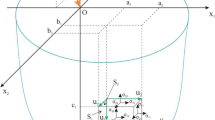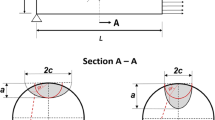Abstract
In this paper, a new semi-analytical and semi-engineering method of the closed form solution of stress intensity factors (SIFs) of cracks emanating from a surface semi-spherical cavity in a finite body is derived using the energy release rate theory. A mode of crack opening displacements of a normal slice is established, and the normal slice relevant functions are introduced. The proposed method is both effective and accurate for the problem of three-dimensional cracks emanating from a surface cavity. A series of useful results of SIFs are obtained.
Similar content being viewed by others
References
Albuquerque, C., Silva, A. L. L., de Jesus, A. M. P., and Calçada, R. An efficient methodology for fatigue damage assessment of bridge details using modal superposition of stress intensity factors. International Journal of Fatigue, 81, 61–77 (2015)
Ayhan, A. O. and Yucel, U. Stress intensity factor equations for mixed-mode surface and corner cracks in finite thickness plates subjected to tension loads. International Journal of Pressure Vessels and Piping, 88, 181–188 (2011)
Sripichai, K. and Pan, J. Closed form structural stress and stress intensity factor solutions for spot welds in square overlap parts of cross tension specimens. Engineering Fracture Mechanics, 96, 307–327 (2012)
Perl, M. and Bernshtein, V. Three dimensional stress intensity factors for ring cracks and arrays of coplanar cracks emanating from the inner surface of a spherical pressure vessel. Engineering Fracture Mechanics, 94, 71–84 (2012)
Raju, I. S. and Newman, J. C., Jr. Stress-intensity factors for a wide range of semi-elliptical surface cracks in finite-thickness plates. Engineering Fracture Mechanics, 11, 817–829 (1979)
Chang, J. H. and Wu, D. J. Stress intensity factor computation along a non-planar curved crack in three dimensions. International Journal of Solids and Structures, 44, 371–386 (2007)
Perl, M. and Bernshtein, V. 3-D stress intensity factors for arrays of inner radial lunular or crescentic cracks in thin and thick spherical pressure vessels. Engineering Fracture Mechanics, 78, 1466–1477 (2011)
Liu, G. R. On G space theory. International Journal of Computational Methods, 6, 257–289 (2009)
Sripichai, K. and Pan, J. Closed-form structural stress and stress intensity factor solutions for spot welds in square plates under opening loading conditions. Engineering Fracture Mechanics, 93, 168–188 (2012)
Sutradhar, A. and Paulino, G. H. Symmetric Galerkin boundary element computation of T-stress and stress intensity factors for mixed-mode cracks by the interaction integral method. Engineering Analysis with Boundary Elements, 28, 1335–1350 (2004)
Xiao, X. K. and Yan, X. Q. A numerical analysis for cracks emanating from a surface semi-spherical cavity in an infinite elastic body by FRANC3D. Engineering Failure Analysis, 15, 188–192 (2008)
Alatawi, I. A. and Trevelyan, J. A direct evaluation of stress intensity factors using the extended dual boundary element method. Engineering Analysis with Boundary Elements, 52, 56–63 (2015)
Lee, D. S. Torsion of a long circular cylinder having a spherical cavity with a peropheral edge crack. European Journal of Mechanics-A/Solids, 21, 961–969 (2002)
Lee, D. S. Tension of a long circular cylinder having a spherical cavity with a peripheral edge crack. International Journal of Solids and Structures, 40, 2659–2671 (2003)
Stefanescu, D., Edwards, L., and Fitzpatrick, M. E. Stress intensity factor correction for asymmetric through-thickness fatigue cracks at holes. International Journal of Fatigue, 62, 535–553 (2003)
Kastratović, G., Grbović, A., and Vidanović, N. Approximate method for stress intensity factors determination in case of multiple site damage. Applied Mathematical Modelling, 39, 6050–6059 (2015)
Yan, X. Q. An effective method of stress intensity factor calculation for cracks emanating from a triangular or square hole under biaxial loads. Fatigue and Fracture of Engineering Materials and Structures, 26, 1127–1133 (2003)
Yan, X. Q. A numerical analysis of cracks emanating from a square hole in a rectangular plate under biaxial loads. Engineering Fracture Mechanics, 71, 1615–1623 (2004)
Yan, X. Q. A numerical analysis of cracks emanating from an elliptical hole in a 2-D elasticity plate. European Journal of Mechanics-A/Solids, 25, 142–153 (2006)
Yan, X. Q. Cracks emanating from circular hole or square hole in rectangular plate in tension. Engineering Fracture Mechanics, 73, 1743–1754 (2006)
Xan, X. Q. and Liu, B. L. A numerical analysis of cracks emanating from a surface elliptical hole in infinite body in tension. Meccanica, 46, 263–278 (2011)
Zhao, W., Newman, J. C., Jr., Sutton, M. A., Wu, X. R., and Shivakumar, K. N. Stress intensity factors for corner cracks at a hole by a 3-D weight function method with stresses from the finite element method. Fatigue and Fracture of Engineering Materials and Structures, 20, 1255–1267 (1997)
Lin, X. B. and Smith, R. A. Stress intensity factors for corner cracks emanating from fastener holes under tension. Engineering Fracture Mechanics, 62, 535–553 (1999)
Perl, M., Steiner, M., and Perry, J. 3-D stress intensity factors due to autofrettage for an inner radial lunular or crescentic crack in a spherical pressure vessel. Engineering Fracture Mechanics, 131, 282–295 (2014)
Perl, M. and Steiner, M. 3-D stress intensity factors due to full autofrettage for inner radial or coplanar crack arrays and ring cracks in a spherical pressure vessel. Engineering Fracture Mechanics, 138, 233–249 (2015)
Wang, Q. Z. and Zhang, X. A closed form solution about stress intensity factors of shear modes for 3-D finite bodies with eccentric cracks by the energy release rate method. International Journal of Solids and Structures, 36, 971–998 (1999)
Liu, L. M., Wang, Q. Z., and Zhang, X. Explicit closed form solution of stress intensity factors for three-dimensional finite bodies with small corned cracks. Journal of Mechanical Strength, 26, 80–86 (2004)
Wu, J. G., Wang, Q. Z., Zhang, X., and Li, H. B. Explicit closed form solutions for threedimensional stress intensity factors based on the energy release rate theory. Chinese Journal of Ship Research, 9, 81–90 (2014)
Isida, M. and Nakamura, Y. Edge cracks originating from an elliptical hole in a wide plate subjected to tension and in-plane shear. Transactions of the Japan Society of Mechanical Engineers, 46, 947–956 (1980)
Wu, S. F., Zhang, X., and He, Q. Z. Functional variable displacement method in analysis of singularity near the corner point in a three dimensional cracked solid. Engineering Fracture Mechanics, 31, 191–200 (1988)
Author information
Authors and Affiliations
Corresponding author
Rights and permissions
About this article
Cite this article
Wan, H., Wang, Q. & Zhang, X. Closed form solution of stress intensity factors for cracks emanating from surface semi-spherical cavity in finite body with energy release rate method. Appl. Math. Mech.-Engl. Ed. 37, 1689–1706 (2016). https://doi.org/10.1007/s10483-016-2148-8
Received:
Revised:
Published:
Issue Date:
DOI: https://doi.org/10.1007/s10483-016-2148-8




